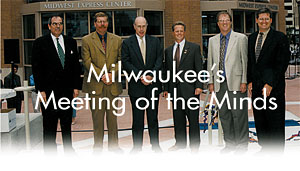
Getting a large structure up and running is usually fraught with massive glitches. Confusion reigns at the jobsite. Specifications are ignored, changeorders are common, schedules are shredded, shipments are missed, and cost overruns pileup. As one consulting engineer put it, "Completing a building on time and on budget is like driving a car from Memphis to Phoenix in second gear."
He added, "It's no fun in construction today. Too many lawsuits."
One bright exception to this gloomy picture is Milwaukee's 667,000-sq-ft Midwest Express Center. The $167 million multiuse structure requires a complex set of climate controls to accommodate a variety of functions. It covers four square blocks in downtown Milwaukee. Construction became even more challenging in that during mid-construction, the older facility in the middle of downtown to be replaced was demolished - an activity that entailed safety and environmental aspects.
How did the Midwest Express Center builders dodge the usual frustrations of a large project? John S. Nelson, president of Affiliated Engineers, Inc. (AEI), a Madison-based consulting engineer group that designed the facility's mechanical-piping-electrical system, credits the design-build (D-B) process. This complex project has earned AEI the Engineered Systems Engineering Team Award. The mechanical contractor was Downey Mechanical, based in Milwaukee.
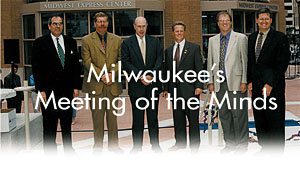
Laying The Groundwork
Nelson listed the key reasons for the relatively smooth, two-year project. First, the construction team used a D-B process, the largest ever used on a building in Wisconsin, in which cooperative elements blend together to resolve quickly the inevitable problems that arise, rather than cobbling together a makeshift solution in the eleventh hour. D-B contrasts with the traditional bid-spec system where a top-down hierarchy of authority - from owner to consultant to general contractor to specialty mechanical contractors - breeds misunderstandings and inefficiency.D-B also diffuses the authority and responsibility among specialists. The process also reintegrates the functions of design and construction. Close contact via fax, phone, and e-mail tighten up the communication among participants. With the center, six companies participated, covering functions like architecture, structural/civil engineering, and of course, climate control. Second, the builders took six months to hammer out a labor contract with the Milwaukee Building and Construction Trades Council. The final agreement included not only wages but also such thorny issues as drug testing, safety goals, and minority hiring levels. More importantly, the management extracted from the union a no-strike clause, ensuring that deadlines would be met. Here, fast track meant fast track.
Third, an enlightened owner - the Wisconsin Center District - started with a brace of consultants to advise it, headed by Barton Malow Construction Services. Other professionals were appointed for the center's operation, ZHA, Inc.; for the environment, RMT, Inc.; for food service, Fine Host Corp.; and design and construction, Cream City Associates, Inc.
Fourth, before the groundbreaking ceremony, the construction process underwent a radical change to the very substance of the building, from all-steel to structural concrete for much of the facility. This switch resulted from a "value engineering" decision that goes to the heart of D-B flexibility: the ability of participating engineering firms to adjust to a radically different building profile.
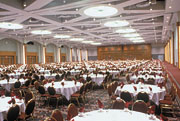
A Building With Complex Needs
The project required an hvac system that matched its needs. "It's a dynamic building with many uses," Nelson said, including administrative, dining, multiple exhibitions, and food preparation. "These required a controls system that matched different occupancies at different times." For example, the meeting room can be collapsed into many different configurations with different cooling loads. But the variable-air volume (vav) system can be modulated to accommodate whatever size the rooms take. Another potentially tough area was the "prefunction" space where occupants gather for short periods of time, either waiting to enter one of the larger spaces or during an intermission. "Because one of its walls is a 70-ft-high glass surface, we might have had a challenging solar heat buildup, but the nature of the prefunction space is that its human occupancy is for a short time - people gathering briefly to enter another space or taking a break or intermission," he said.Nelson credited two other team members, William Shook of Clark Construction and John Hunzinger of Hunzinger Construction for their plan that positioned the prefunction space in an area that minimized the large energy-consumption that usually accompanies this function.
Another challenge was meeting the comfort requirements of persons in meeting rooms that are expandable from very small to very large; food preparation sites; a convention area; and a generous area for general assembly.
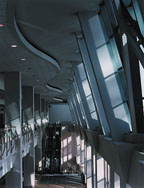
Hosting The Nation's Governors
Phase I of the center, whose debut on July 25, 1998, saw the gathering of 50,000 attendees to the National Governors' Association. The dazzling new structure was constructed during the administration of Wisconsin's Governor Tommy Thompson, who cracked the whip. Under the glare of the national media spotlight, if Murphy's Law was ever to take hold, it was then. "The building performed beautifully," said Nelson, thanks to a strict checklist.The construction team had run the building through its mechanical paces, testing each mechanical element. The centrifugal chillers worked fine. The controls system directed the air handlers to provide the right ventilation rates. The lighting system was modulated to meet the demands of each component of the building. No switch remained unswitched, no toilet remained unflushed.
Since its opening, the center has operated through two heating-cooling cycles in Milwaukee's harsh climate, and its temperature control system has withstood the challenge of keeping thousands of occupants comfortable throughout a wide variety of events. The building has been used for retirement dinners, awards ceremonies, corporate sales meetings, and religious and civic functions. There is even a subcategory of uses that test the air-handling system. These include exhibit setup and take down, vehicular operations, and the loading area for exhibits.
And there is the atrium, which contains multiple mezzanine levels, stairs, escalators, and a 7-ft ceiling height composed of all glass on its two exposures. AEI designers developed horizontal mullions at three vertical elevations to run continuously along the exterior glazing. This concealed the perimeter radiation for heating. The air conditioning and ventilation supply air is detailed at soffits at each mezzanine level, which the return air is detailed into and concealed by the clouds that create the ceiling in the space.
An added feature is a ventilation system to respond to the smoke evacuation requirements of the atrium space. Here, a smoke evacuation control sequence is initiated by the fire alarm system that operates dampers in the return air ducts.
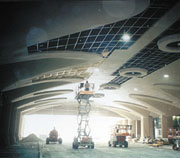
Three Major Equipment Spaces
The facility contains several major equipment spaces. These are: the central plant; two linear equipment rooms on both sides of the exhibit hall to serve ballroom, meeting room, and ancillary support functions; and equipment penthouses to serve the exhibition hall. The equipment rooms house the air handling and exhaust equipment, motor control centers, and electrical distribution equipment. Electrical bus ducts run high in the space, providing a source for 490V and 208V power to satisfy the larger power needs than can be gotten from the floor boxes.The central plant houses equipment for steam, heated and chilled water, domestic hot water, compressed air, and electrical services. Three Trane centrifugal chillers carry the load. Two 1,250-ton chillers and a single 500-ton chiller can be adjusted to accommodate full or partial load.
Steam at 125 psig, provided by the Wisconsin Electric Power Company (WEPCO), is used for domestic water and space heating. The utility's electric service goes through the central plant, with power subdistributed to major load centers. The high-pressure steam is used to minimize the piping size, maintain distribution efficiency, and serve the kitchen area. The steam is reduced to 15 psig at pressure-reducing stations in each mechanical equipment room and the central utility plant.
A single air-handling unit (ahu) with a variable frequency drive serves the entire 37,000-sq-ft ballroom space, with a similar system for the meeting rooms. Flanking the exhibit hall above the upper level are mechanical rooms, which house air handling and exhaust equipment, motor control centers, and electrical distribution equipment. Located on the exterior above the central plant are Baltimore Air Coil Company (Baltimore) cooling towers. All air-handling equipment complies with ASHRAE Standard 62 requirements for a "no smoking" facility, including ventilation rates and enhanced air filtration.
Twenty-two ahu's with a total of 900,000-cfm capacity serve the center. The units range from single zone to multizone with constant volume and vav. Eight single-zone, constant-volume air handlers serve the exhibition hall.
The hvac system design, using a building automation system (bas) from Johnson Controls, Inc. (Milwaukee), also reduces the outside air load by about one third, while remaining in compliance with ASHRAE 62-1989, and the state administrative code. In turn, this reduces the cooling load to 3,000 tons. Once the building was inaugurated and running, the owners were taken aback at the increased utility expense for the first heating season, said project engineer Pat Coenen.
"The owner's staff was used to the smaller heating bills for the smaller building that preceded the new structure, which was more than twice as large," he said. Also, the staff had to grow accustomed to the new bas, which was far more advanced and precise than the controls system in the previous exhibit hall, which was relatively more primitive.
In the beginning, the staff left air handlers running around the clock, whether they were needed or not. But in the later months, they paid closer attention to these details and the efficiencies began to show through.
In a related matter, AEI, along with other professionals, assisted the owners with an O&M system to ensure that there is no degradation of operation or efficiency.
Serving Public And Private Clients
Nelson summarized the difference between designing a system for a public entity and a private company."With a public building, there is not a lot of flexibility. Their regulations must be followed unless you can make a case for a different decision. In addition, there is a lot more public scrutiny. After all, it's the people's tax dollars going to work.
"With a private building there is more flexibility because the owners don't have to account to a public audience, only their own interest."
But, he added, if a job goes sour with cost overruns, it is easier for a professional to take a public entity to court than a private sector client. Not that Nelson goes to court much - only twice since the firm was started in 1978.
With the new Midwest Express Center, there was only one potential brush with litigation. It was nothing of a mechanical nature, but the very ground on which the facility was sited. The question was possible soil contamination, because for a century and a half, many different businesses had operated on parcels of this land. But the soil was fine, and its new occupant is a stunning addition to Milwaukee's skyline. ES
Engineering Team Award Winning Project Team
Wilson Shook - Executive Vice President, Clark Construction CompanyJohn Hunzinger, P.E. - President, Hunzinger Construction Company
John Kissinger - Principal, Graef Anhalt Schloemer & Associates
H. Preston (Bo) Crum - Senior Principal, Thompson, Ventulett, Stainback, and Associates
Charles Engberg, AIA - Principal, Engberg Anderson Design Partnership, Inc.
John S. Nelson, P.E. - CEO, Affiliated Engineers, Inc.ES
Many Contributors To Large Project
Milwaukee's new Midwest Express Center has drawn rave reviews for its form and function. The final product has managed to smoothly unite Milwaukee's historical architectural look with a modernistic style that spruces up the area around the four-city-block space on which it is situated.The center, as a publicly funded building, was a high-wire act, because it was subjected to remorseless scrutiny and intense pressure. Add to this mix the political pressure of the mayor and the governor. Any delay or interruption of the schedule would make headlines in the local media. In the end, however, the owners wanted not only a marquee building but also a tourist attraction, and that's what they got.
Even as impressive as the structure is, the teamwork of the professionals who were responsible for its completion is even more striking. They brought the center in on time and on budget. More than a dozen firms participated, ranging from interior design and landscape design, to food service and acoustics. The participants form a "who's who" of the construction sector in the region.
The roadmap of who did what on the team begins, of course, with the owner, the Wisconsin Center district - in short, the city of Milwaukee - which designated its own consultant, Barton Malow Construction Services. This Detroit-based company recommended the design-build (D-B) approach for many reasons, among them that a D-B team would be influential in dealing with the labor unions as well as the owner.
When the project got the green light, competition for the job from other construction firms was hot and heavy, including HOK, Inc., a St. Louis-based builder of sports stadiums, and Perini Corp. from Framingham, MA. The two firms lost out to a quickly assembled consortium of firms dubbed Cream City Associates.
Said Barton Malow's vice president, Charles Opferman, "The dynamics of the process were effective in controlling cost and schedule creep," adding that the center was "the most complex I've ever seen."
Barton Malow guided its client in the first stages of selecting the first four specialty firms: the convention center, ZHA, Inc.; environment, RMT, Inc.; food service, Fine Host Corp.; and design/construction, Cream City Associates. Cream City is the entity from which the whole construction activity begins. It is a joint venture of three entities: Clark Construction Group (Bethesda, MD); Hunzinger Construction Co. (Milwaukee); and D*4 Associates, LLC. Clark Construction spearheaded much of the project. In turn, D*4 is composed of Engberg Anderson Design Partnership (Milwaukee); Thompson, Ventulett, Stainback & Associates (Atlanta); Affiliated Engineers, Inc., (Madison, WI); and Graef, Anhalt, Scholemer & Associates, (Milwaukee).
Out of this welter of professionals came the decision to make a D-B project, whose members were chosen largely with the input from Hunzinger Construction, which knew the need for specialists to satisfy the technical complexity involved. As part of the competition, each of the firms spent between $100,000 and $200,000 to bear costs of their planning. This included models, schedules, and other ingredients to ensure deadlines were met.
The Cream City team included two dozen design-team firms, the Clark/Hunzinger construction joint venture, and 60 subcontractors. Among the latter were workers that met project goals of 25% minority and 5% women enterprise participation.
Sitting Around The Table
How do you get this disparate group of talents, each with its own traditions and work practices, to pull together? Management retained a facilitating specialist, Campana Consulting (Orlando, FL).
The first session, lasting eight hours, yielded a mission statement of 10 goals. Also settled were clear and distinct lines of communication to ease the decision-making process. Also arising from the meeting was the fact that the hvac, piping, and other mechanical elements needed an early resolution - which happened.
What followed was a sustained, seven-month series of meetings to attain a core objective: an adjusted, guaranteed maximum price. This took into account such key items as refined programming, schematic design, value engineering, and alternative system and material choices. The objective here was to generate revenue, enhance maintenance, life cycle costs, operational efficiency, and aesthetics. Differences and disagreements were inevitable, but were overcome by a common objective.
One example of how these meetings solved problems early involved the structural framework. The initial plan was to use steel, but this was switched to concrete when it became apparent that getting steel to the jobsite would involved costly delays. The switch saved more than $700,000.
Another result of the D-B process was the efficient management of construction employees. At one point, during peak hours, more than 350 workers were on site daily - piping specialists, sheet metal workers, plasterers, lighting personnel - without the chaos that could result from this concentration of human beings. Maybe even more important, the efficient scheduling of these hundreds of workers ensures that they would not disturb surrounding businesses, in particular a large shopping mall.
Midwest Express Center was the result of an express idea: design-build.
-Thomas Mahoney
